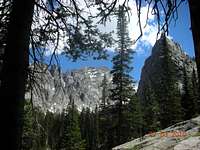-
 20188 Hits
20188 Hits
-
 72.64% Score
72.64% Score
-
 3 Votes
3 Votes
|
|
Area/Range |
|---|---|
|
|
40.07407°N / 105.66625°W |
|
|
Hiking, Mountaineering, Mixed, Scrambling |
|
|
Spring, Summer, Fall, Winter |
|
|
13441 ft / 4097 m |
|
|
Overview
Lone Eagle Cirque is a set of six beautiful peaks around Crater Lake in the Indian Peaks Wilderness. These six peaks all are gorgeous, but none of them compare to the glory of Lone Eagle Peak from Crater and Mirror Lakes. (See Primary Image) The peaks here all surround Crater Lake, and the views of all the peaks are astounding from this trail. Also, all along the trail, especially earlier in the summer, wildflowers abound along the trail. The other harder access is to the back of these peaks by hiking to the "Lost Tribe Lakes". There are six peaks in this area. From the north, and from east to west, there is Apache Peak, Lone Eagle Peak, “Iroquois Peak”, “Hopi Peak”, Mount Achonee, and “Cherokee Peak”. The main way to make it into this area is filled with flowers and waterfalls. It is a wonderful area to go to.Getting There
The easiest way to access the Lone Eagle cirque is to follow the Crater Lake Trail up to Crater Lake. To get to the Monarch Lake Trailhead, drive north out of Granby for five miles to a dirt road on the right. Turn right onto the dirt road, and pay $5 to enter the Arapahoe National Recreation Area. After paying your fee, drive down the road along the southern shore of Lake Granby for around ten miles to a road intersection. From here, follow the signs for the Monarch Lake Trailhead, and park at the trailhead along the road. The trail starts at the northwestern point of the lake at the Ranger Station. There is a mileage sign at the trailhead, and from there, you have eight miles to go to Crater Lake. Go left on the Cascade Creek Trail along Monarch Lake. Follow this for 1.5 miles to the intersection with the trail around Monarch Lake. Stay left at the trail intersection and stay on the beautiful trail as it passes the Buchanan Pass Trail on the left, and stays along Cascade Creek. After four miles, reach Cascade Falls. This waterfall is a gorgeous sight, especially earlier in summer when it is really pumping. This is a great place to stop and take a break. After the falls, the trail steepens to the top of the falls, before leveling out to a much gentler incline. From here, the views of Lone Eagle Cirque begin to open up, with Apache Peak seen straight ahead. After 6.75 miles, stay right at the intersection with the Pawnee Pass Trail, and the final leg of the hike in begins.Follow the Crater Lake Trail for 0.8 miles to Mirror Lake. From here enjoy the absolute stunning view of Lone Eagle Peak and Fair Glacier. This small lake has stunning views of Lone Eagle, but when you reluctantly decide to go on, stay on the trail for the last quarter of a mile to Crater Lake. Now the view of the Lone Eagle Cirque is in view. Apache Peak is the only peak that can’t be seen from Crater Lake.
The other way to get to Lone Eagle Cirque is by getting to a set of Lakes unofficealy known as the "Lost Tribe Lakes". These lakes provide access to the north sides of "Hopi Peak", as well as "Iroquois Peak". To access these pristine lakes, follow the Arapaho Pass trail from either Monarch Lake, or from the Fourth of July Trailhead to 10,300 feet in Coyote Park. That is the easy part. Locate a faint trail that goes into Wheeler Park, and follow this for a mile to around 10,500 feet. From here, turn off of the trail, and turn north and do a bushwhack for 0.6 mile to 11,200 feet to "Lower Lost Tribe Lake". This is a very beautiful area to camp in for climbing other "Hopi" and "Iroquois". From here, it is easy to access the north faces of "Hopi" and "Iroquois".
The peaks
There are many routes to the peaks from Crater Lake. However, none of them are walk ups. All route pages from the peaks in this area are attached as children.Apache Peak- first, while this peak is mainly climbed from the east, I put this peak on the Lone Eagle Cirque because one route is climbed from Crater Lake. This route is Fair Glacier. This snow climb, which Gary Roach considers in his Indian Peaks Wilderness book to be one of the best snow climbs in Colorado. To reach this glacier, from Mirror Lake, head to the left around Lone Eagle Peak to Triangle Lake. From Triangle Lake, Fair Glacier rises right up in the headwall of this small valley. Climb up to the top of the glacier then scramble up rocks to the summit.
Lone Eagle Peak- there are two routes up this peak: the Solo Route, and the North Face. See Lone Eagle Peak for details on these routes
“Iroquois Peak”- this peak can be climbed from Hopi Peak. There is currently no page on Iroquois Peak, so right now, someone needs to add the page.
“Hopi Pak”- this peak can be climbed from either the Hopi Glacier, which is not marked on topo maps, or from the summit of Mount Achonee.
Mount Achonee- this peak can be climbed from its northeast gully route, or from the summit of Hopi Peak. See the Mount Achonee Page for more details on this route.
The final peak is “Cherokee Peak”- this peak can be climbed from on its northeast ridge, from Crater Lake. See the Cherokee Peak page for more details





